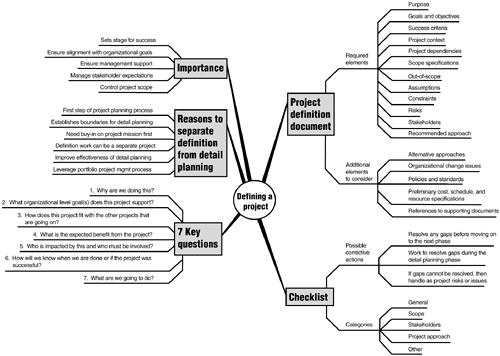Project Definition Checklist
Here's a checklist that can help you to determine if your project is defined properly and if you are ready to proceed to the next iteration of detailed planning. If you find that your project is not properly defined, you have the following options available to you:
- Resolve any gaps with appropriate stakeholders before moving onto next phase
- If the project has already been defined, work to resolve these gaps during the detail planning phase.
- If gaps cannot be resolved, then handle as project risks or issues (whichever is appropriate for the specific gap).
General
- Is it clear why this is project is being undertaken?
tip

For anyone who has not attended a Goal Setting 101 course, let's do a quick review of SMART goals.
Actually, I've seen two different definitions of SMART goals, and they both apply:
Definition #1SMART goals are Specific, Measurable, Achievable, Rewarding, and Time-based.
Definition #2SMART goals are Specific, Measurable, Agreed-To, Realistic, and Time-based.
Perhaps, the acronym should be SMAARRT. For projects, the second definition is more important due to the "Agreed-To" element.
- Is there a clear picture of the desired results of this project?
- Is there a clear picture of how this project fits within the organizational landscape?
- Do you understand who is funding the project initiative?
- Is there a gap between available and needed funds?
- Is the gap between the current state and the desired future state clearly documented and understood?
- Has the expected "change impact" on existing business processes, customers, systems and staff been clearly documented?
- Have the success factors been identified? Are they complete? Are they SMART?
- Have any future state performance targets been defined as success factors? Are they SMART?
Scope
- Does project scope indicate boundaries between impacted processes, systems, and organizations?
- Is project scope defined clearly enough to show when scope creep is occurring?
- Have any external process or system interfaces that will be impacted by this project been identified?
- Has the process workflow between business units or business functions been properly considered?
- Have the organizational and geographic boundaries been clearly defined?
- Does project scope include related items that are out-of-scope?
- Does project scope include any other organizational or technology-based initiative that is needed to fully support the project objective?
- If project scope includes any requirements, have the requirements been properly validated?
- Have any and all project constraints been identified?
- Have any and all project assumptions been identified?
- Are there any known policies, regulations, or standards that will apply to this project (such as procurement, quality, security, regulatory compliance, and so on)?
Stakeholders
- Has the project sponsor been identified and engaged?
- Is each impacted business unit and business process step represented on the project team?
- Is each customer group represented on the project team?
- Are all stakeholders identified in a project organization chart?
- Are the reporting relationships indicated in the project organization chart?
- Are project roles described and assigned to each stakeholder?
- Have we identified which stakeholders will form the core management steering committee?
- Have we identified which stakeholders will need to review and approve any requested change to the project definition?
Project Approach
- Does the recommended approach explain why it was selected over the alternatives?
- Are the proposed technologies, strategies, and methodologies documented?
Other
- Are the project definition elements documented?
caution

As with all project documents, make sure you have a way to control changes to the Project Definition document and that you have proper backups of it.
Your Configuration Management Plan (discussed in Chapter 12, "Managing Project Deliverables") will document this.
- Is the Project Definition document under configuration management (version control)?
- Have high level risks and planned responses been identified?
- Has preliminary timeline and budget been stated? Are the supporting reasons and assumptions documented?
Acceptance
- Have all stakeholders reviewed, agreed upon, and approved the Project Definition document?
- Has the project and the project manager been officially authorized?
Part i. Project Management Jumpstart
Project Management Overview
- Project Management Overview
- What Is Project Management…Exactly?
- What Is the Value of Project Management?
- Why Are Projects Challenging?
- Growing Demand for Effective Project Managers?
- Trends in Project Management
The Project Manager
- The Project Manager
- One Title, Many Roles
- Key Skills of Project Managers
- Qualities of Successful Project Managers
- 15 Common Mistakes of Project Managers
Essential Elements for any Successful Project
- Essential Elements for any Successful Project
- What Exactly Is a "Successful" Project?
- Learning from Troubled Projects
- Learning from Successful Projects
- Essential Project Manager Toolkit
Part ii. Project Planning
Defining a Project
- Defining a Project
- Setting the Stage for Success
- How Does Defining a Project Relate to Project Planning?
- Project Definition Document
- Project Definition Checklist
Planning a Project
- Planning a Project
- Key Project Planning Principles
- Important Questions Project Planning Should Answer
- Building a Project Plan
- Summary of Supplemental Project Plan Components
- Project Plan Checklist
Developing the Work Breakdown Structure
- Developing the Work Breakdown Structure
- What Is a WBS Exactly?
- Why Is the WBS Important?
- The Process of Building a WBS
Estimating the Work
- Estimating the Work
- Next Step in the Schedule Development Process
- Managing the Risk, Managing the Estimates
- Reasons for Estimating Woes
- Powerful Estimating Techniques and Methods
- Best Practices
Developing the Project Schedule
- Developing the Project Schedule
- The Impact of the Project Schedule
- The Goal of the Schedule Development Process
- Key Inputs for Building a Schedule
- Creating a Schedule
Determining the Project Budget
- Determining the Project Budget
- The Impact of the Project Budget
- Principles of an Effective Budget
- Creating a Project Budget
- Common Budget Challenges
Part iii. Project Control
Controlling a Project
- Controlling a Project
- What Is Project Control?
- Management Fundamentals for Project Control
- Powerful Techniques for Project Control
- Performance Reporting
- Variance Responses
- Leveraging Earned Value Management Concepts
- Common Project Control Challenges
- Lessons from Project Recoveries
Managing Project Changes
- Managing Project Changes
- What Exactly Is a Project Change and Whats the Big Deal Anyway?
- Fundamentals for Managing Project Change
- What Causes Unplanned Scope Changes?
- Essential Elements of a Project Change Control System
- Powerful Techniques for Minimizing Project Changes
- Common Project Change Control Challenges
Managing Project Deliverables
- Managing Project Deliverables
- "Managing Project Deliverables" Means What Exactly?
- Why Do This? Its Too Much Work
- Identify, Protect, and Track: The Principles of Managing Work Products
- Best Practices
- Configuration Management Plan
- Common Challenges and Pitfalls
Managing Project Issues
- Managing Project Issues
- The Goals, Objectives, and Principles of Project Issue Management
- Key Features of Issue Management System
- Options for Issue Log
- Best Practices
- Some Special Situations
Managing Project Risks
- Managing Project Risks
- Key Risk Management Principles
- The Essential Process for Managing Project Risks
- The Common Sources of Project Risk
- Typical Problems
- Powerful Risk Control Strategies
- Are You Sure Its a Risk?
Managing Project Quality
- Managing Project Quality
- What Is "Project Quality"?
- Unique Aspects of Managing Project Quality
- Principles of Managing Project Quality
- Powerful Tools and Techniques for Project Quality
- Powerful Quality Strategies
- Typical Quality-Related Challenges
Part iv. Project Execution
Leading a Project
- Leading a Project
- More Than Managing
- Where Is Leadership Needed on a Project?
- Twelve Keys to Better Project Leadership
- Power of Servant Leadership Approach
Managing Project Communications
- Managing Project Communications
- What Are Project Communications?
- The Importance of Project Communications
- Why Communicating Can Be Tough
- Seven Powerful Principles
- Best Practices of Effective Project Communicators
Managing Expectations
- Managing Expectations
- Value of Reviewing Stakeholder Expectation Management
- Critical Aspects of Expectations
- Seven Master Principles of Expectation Management
- Essential Elements of Managing Expectations
Keys to Better Project Team Performance
- Keys to Better Project Team Performance
- High-Performing Teams
- Ten Key Principles
- Proven Techniques
- Special Situations
Managing Differences
- Managing Differences
- Five Key Principles
- Proven Techniques for Leading Cross-Functional Projects
- Proven Techniques for Leading Cross-Cultural Projects
- Proven Techniques for Leading Virtual Projects
Managing Vendors
- Managing Vendors
- First, Lets Clarify a Few Terms
- Ten Proven Principles of Vendor Management
- Twelve Tips for Buyers
- Seven Tips for Sellers
- Twelve Key Project Management Skills for Better Vendor Management
- Stuff You Need to Know About Contracts
Ending a Project
EAN: N/A
Pages: 169

